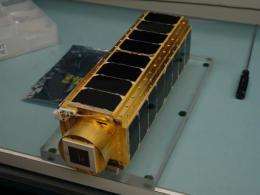Nanosatellite to Study Antifungal Drug Effectiveness in Space

(PhysOrg.com) -- NASA is preparing to fly a small satellite about the size of a loaf of bread that could help scientists better understand how effectively drugs work in space. The nanosatellite, known as PharmaSat, is a secondary payload aboard a U.S. Air Force four-stage Minotaur 1 rocket planned for launch the evening of May 5.
PharmaSat weighs approximately 10 pounds. It contains a controlled environment micro-laboratory packed with sensors and optical systems that can detect the growth, density and health of yeast cells and transmit that data to scientists for analysis on Earth. PharmaSat also will monitor the levels of pressure, temperature and acceleration the yeast and the satellite experience while circling Earth at 17,000 miles per hour. Scientists will study how the yeast responds during and after an antifungal treatment is administered at three distinct dosage levels to learn more about drug action in space, the satellite's primary goal.
The Minotaur 1 rocket is on the launch pad at NASA's Wallops Flight Facility and the Mid-Atlantic Regional Spaceport located at Wallops Island, Va. The Wallops range is conducting final checkouts. The U.S. Air Force has announced that the rocket could launch at any time during a three-hour launch window beginning at 8 p.m. EDT May 5.
"Secondary payload nanosatellites expand the number of opportunities available to conduct research in microgravity by providing an alternative to the International Space Station or space shuttle conducted investigations," said Elwood Agasid, PharmaSat project manager at NASA's Ames Research Center in Moffett Field, Calif. "The PharmaSat spacecraft builds upon the GeneSat-1 legacy with enhanced monitoring and measurement capabilities, which will enable more extensive scientific investigation."
After PharmaSat separates from the Minotaur 1 rocket and successfully enters low Earth orbit at approximately 285 miles above Earth, it will activate and begin transmitting radio signals to two ground control stations. The primary ground station at SRI International in Menlo Park, Calif., will transmit mission data from the satellite to the spacecraft operators in the mission control center at NASA's Ames Research Center. A secondary station is located at Santa Clara University in Santa Clara, Calif.
When NASA spaceflight engineers make contact with PharmaSat, which could happen as soon as one hour after launch, the satellite will receive a command to initiate its experiment, which will last 96 hours. Once the experiment begins, PharmaSat will relay data in near real-time to mission managers, engineers and project scientists for further analysis. The nanosatellite could transmit data for as long as six months.
"PharmaSat is an important experiment that will yield new information about the susceptibility of microbes to antibiotics in the space environment," said David Niesel, PharmaSat's co-investigator from the University of Texas Medical Branch Department of Pathology and Microbiology and Immunology in Galveston. "It also will prove that biological experiments can be conducted on sophisticated autonomous nanosatellites."
As with NASA's previous small satellite missions, such as the GeneSat-1, which launched in 2006 and continues to transmit a beacon to Earth, Santa Clara University invites amateur radio operators around the world to tune in to the satellite's broadcast.
More information:
For more information and instructions about how to contact PharmaSat, visit: www.nasa.gov/mission_pages/sma … lsats/pharmasat.html
For the more information about PharmaSat and other small satellite missions, visit: www.nasa.gov/mission_pages/smallsats
Provided by JPL/NASA (news : web)



















